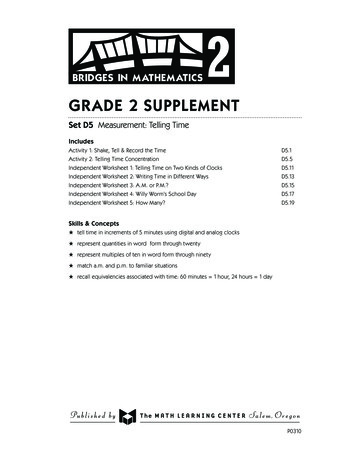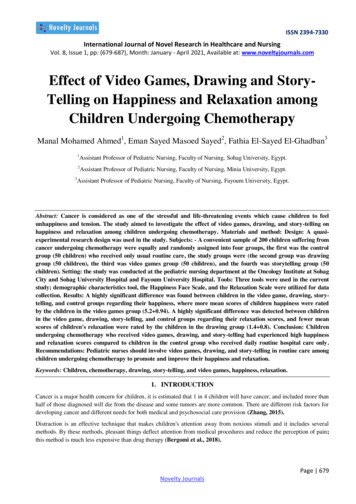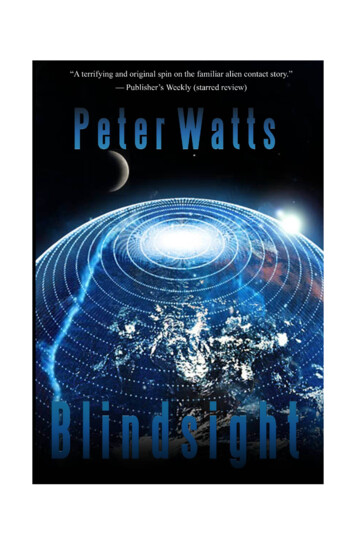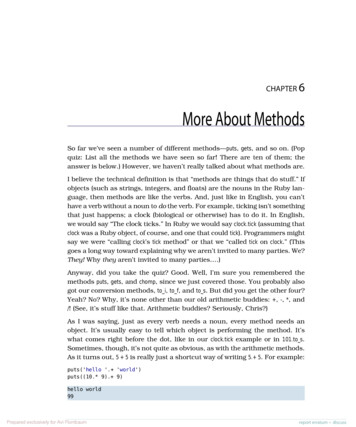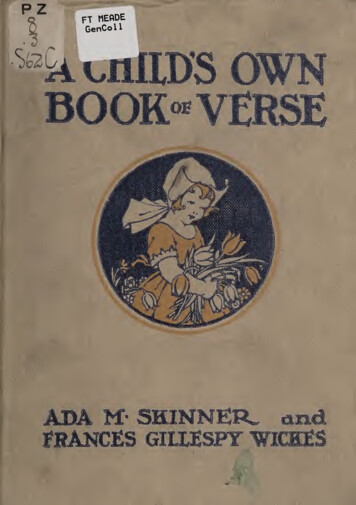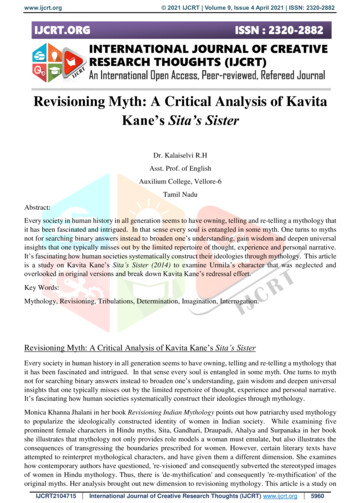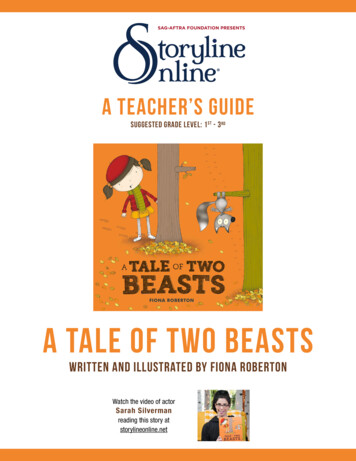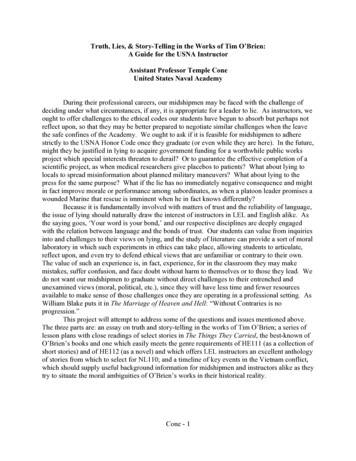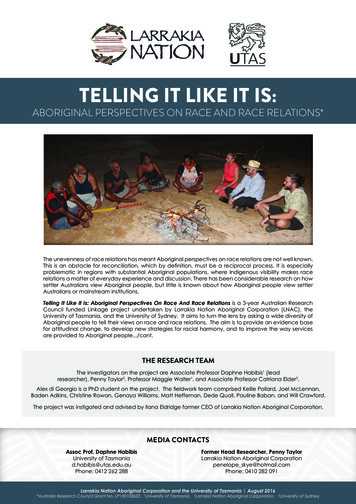
Transcription
TELLING IT LIKE IT IS:ABORIGINAL PERSPECTIVES ON RACE AND RACE RELATIONS*The unevenness of race relations has meant Aboriginal perspectives on race relations are not well known.This is an obstacle for reconciliation, which by definition, must be a reciprocal process. It is especiallyproblematic in regions with substantial Aboriginal populations, where Indigenous visibility makes racerelations a matter of everyday experience and discussion. There has been considerable research on howsettler Australians view Aboriginal people, but little is known about how Aboriginal people view settlerAustralians or mainstream institutions.Telling It Like It Is: Aboriginal Perspectives On Race And Race Relations is a 3-year Australian ResearchCouncil funded Linkage project undertaken by Larrakia Nation Aboriginal Corporation (LNAC), theUniversity of Tasmania, and the University of Sydney. It aims to turn the lens by asking a wide diversity ofAboriginal people to tell their views on race and race relations. The aim is to provide an evidence basefor attitudinal change, to develop new strategies for racial harmony, and to improve the way servicesare provided to Aboriginal people./cont.THE RESEARCH TEAMThe investigators on the project are Associate Professor Daphne Habibis1 (leadresearcher), Penny Taylor2, Professor Maggie Walter1, and Associate Professor Catriona Elder3.Alex di Georgio is a PhD student on the project. The fieldwork team comprised Kellie Pollard, Joel McLennan,Baden Adkins, Christine Rowan, Genaya Williams, Matt Heffernan, Dede Quall, Pauline Baban, and Will Crawford.The project was instigated and advised by Ilana Eldridge former CEO of Larrakia Nation Aboriginal Corporation.MEDIA CONTACTSAssoc Prof, Daphne HabibisUniversity of Tasmaniad.habibis@utas.edu.auPhone: 0412 262 288Former Head Researcher, Penny TaylorLarrakia Nation Aboriginal Corporationpenelope skye@hotmail.comPhone: 0410 282 091Larrakia Nation Aboriginal Corporation and the University of Tasmania August 2016*Australia Research Council Grant No. LP130100622. 1University of Tasmania.2Larrakia Nation Aboriginal Corporation.3University of Sydney
Telling It Like It Is: Aboriginal Perspectives on Race And RaceRelations collected data from nearly 200 in-depth interviews with44 respondents from a cross-section of Darwin’s Aboriginal residentsand visitors, a survey of 474 Aboriginal people living in, or regularlyvisiting, Darwin (matched to the socio-demographic profile ofDarwin’s Indigenous population based on the 2011 Census ofPopulation and Housing), and a community Facebook page.The study asked these respondents: how they view the relationship between themselves and settler Australians their perceptions of settler Australian politics, values, priorities and lifestyles their views on arrangements for governance in Australia what can be done to improve race relations between the Aboriginalpopulation and settler Australians.Some of the findings from our early analysis are provided in the pages that follow.In presenting these findings we would like to thank the many people who helpedmake this project possible, including the members of our Advisory Group, andespecially our respondents who agreed to share their views, and the manycontributors to the Facebook community page. We also thank the Law SocietyPublic Purposes Trust and Telstra for their generous support of the project.Larrakia Nation Aboriginal Corporation and the University of Tasmania August 2016
TELLING IT LIKE IT IS: ABORIGINAL PERSPECTIVES ON RACE AND RACE RELATIONSINTERVIEW FACT SHEET 1LIVING IN DARWINRespondents described Darwin as a pot of different ethnic groups, but one that isn’t melting.They expressed concern at how rapidly Darwin is changing. There are already few spaceswhere Aboriginal people can be themselves without feeling judged or controlled and theinflux of people has increased segregation and tensions. Respondents felt there should bemore Aboriginal control and involvement in decisions about the city. This was especially theview of respondents who identified as Larrakia people. As descendants of the traditionalowners of the Greater Darwin area, they felt their right to a say in the city’s future was notadequately recognised.They do a lot of things wrong, the non-Indigenous, and the greatest wrong“ (is)not acknowledging the Larrakia people.”All that stuff that we’re supposed to be doing. We’re trying to do it but it’s“ ‘after’—afterwork or after the footy or you know. We’re trying to cram,squeeze in our culture. We can’t do it, we can’t.”Yeah so we have these jokes all the time that we step out of our house and“ we’rewhite we’re restricted we feel like we’re in a straitjacket.”A lot of people act stupid. A lot of people act aggro people, especially“ whites.They don’t like our colour. They’re racist people. We don’t talk tothem any more. We just stay on our home. We don’t bother about them.They want to be them kind of person, we don’t care.”Larrakia Nation Aboriginal Corporation and the University of Tasmania - August 2016Page 3
TELLING IT LIKE IT IS: ABORIGINAL PERSPECTIVES ON RACE AND RACE RELATIONSINTERVIEW FACT SHEET 2WHITE VALUES OF INDIVIDUALISM ANDMATERIALISM ARE PROBLEMATICMany respondents admired white Australians for some of their values, including goal setting,education, hard work and self-discipline. However, white values of individualism andmaterialism were perceived as problematic and damaging for people and communities.There was a strong theme that pressure to be materially successful came at the expense ofconnection to family and resulted in loneliness and high levels of stress. It made people selfish,and reluctant to share in the face of need. They saw white people as valuing having a smartcar or home more than they valued looking after family and friends.Some respondents described being tired of being judged for not buying into the consumerculture, or because they put family ahead of work or saving money. Many contrasted theirappreciation of a more moderately paced lifestyle with the constant demands of white ways.They valued their freedom to be who they are, and not to be controlled by white rules thatrequired them to become a different person. The individualism of white Australian culturewas perceived as rewarding self-promoting and self-serving behaviour. In white culture, itis culturally acceptable to put yourself first, even when it is not fair or right to do so. For thisreason, some respondents said engaging with white Australians could be stressful and theyhad difficulty trusting them.“ White people they are like a slave, you know, to their work.”White people stress to the point where they are like [need] medications to“ calmthemselves down.”I still think there’s a feeling of loss there and disconnection .On the surface“ you’rehappy with this money and this car and this house, but, yeah, I don’tthink so.”But I just don’t understand why white people buy their homes, renovate it,“ getexpensive stuff and then they’re old all of a sudden, you know.”People give up their family, they feel sad, they get homesick but they get a“ nicehouse.”Larrakia Nation Aboriginal Corporation and the University of Tasmania - August 2016Page 4
TELLING IT LIKE IT IS: ABORIGINAL PERSPECTIVES ON RACE AND RACE RELATIONSINTERVIEW FACT SHEET 3LIVING IN A NO-WIN WORLDRespondents described their daily experience as one of loss, where the odds are stackedagainst them, no matter what they do. They have already lost their land, and have to dealwith the legacy and the damage caused by colonisation. Now they face enormous pressureto lose their culture. They fight to hang onto the things that are important to them but it feelslike they never have a fair go or a chance to put their view in a way that will be respected.If they want to be successful they have to conform to the demands of white culture andsacrifice the things that make them who they are - family, culture, language and law. This is animpossible, unfair trade-off. Family provides safety, security, comfort, knowledge and a placewhere you can be yourself. If they stay true to who they are the chance of success in a whiteworld is limited. Working hard is good, but you only succeed if you’re white. If you’re Aboriginalthe trade-off only buys entry to the lower rungs of white society. Employers stereotype Aboriginalpeople as unreliable and there’s a lot of discrimination. Respondents described going for jobsbut no one calls back, or being recruited to meet Indigenous employment targets with nocommitment from employers to providing long term or meaningful employment.It always defaults to the expectation that that Aboriginal person must lose,“ giveup that value, that expectation to attend that funeral. That’s what itdefaults to; the Aboriginal person must lose that value. [But] you can’t justlose that value.”Daily I’m juggling with who I am how I talk, how I act and look and“ whatever.So you get it from the whitefellas, you know, that you can’t talkgood English, and then these blackfellas, ‘Why are you acting white, talkingwhite?’”We’re fighting, fighting all the time and none of us mob are winning. Our old“ mobare dead and gone, the mob that used to fight for our rights, you know.You get asked ‘Where’s the fair go?’ There is no more fair go.”“ It’s very hard to work in Darwin because of rejection and refusals.”Larrakia Nation Aboriginal Corporation and the University of Tasmania - August 2016Page 5
TELLING IT LIKE IT IS: ABORIGINAL PERSPECTIVES ON RACE AND RACE RELATIONSINTERVIEW FACT SHEET 4BEING MADE TO FEEL UNCOMFORTABLE IN WHITE SPACESAlmost all respondents described how Aboriginal and non-Aboriginal people occupy differentspatial and social worlds. Different values and cultures make mixing difficult. Respondents saidthey were most comfortable in spaces that are predominantly Aboriginal, where they can bethemselves and feel safe. Outside of these spaces they reported not feeling safe to expressopinions or to relax and behave freely and unselfconsciously. A lack of physical and emotionalsafety was associated with being the only Aboriginal person in a public place or gathering.Many Aboriginal people feel watched, judged or patronised when out in public. There weremany accounts of feeling uncomfortable in places such as restaurants and shopping mallsbecause of being made to feel like they’re different and don’t belong there. For example,being stared at and followed round by security guards. There was a sense of constantly havingto watch how to behave to meet white expectations. These demands make mixing sociallywith white people difficult.I don’t feel comfortable going to a restaurant, going to the shopping“ centre I’m just scared of them staring at us. ”When I go out I just want to go to that place and come straight back without“ anyhassles It’s how people are raised you know to be against Indigenousmob.”Well like me I will be like walking around barefoot into the shopping centre“ herefor instance you know and then people will be looking at me differently,like ‘Why doesn’t he have any shoes on’, you know? Stuff like that. That’swhy I feel uncomfortable talking to people. They look at me differently— like Iam different.”You know ‘you live this, we live this way and you can’t live that way’“ becausepeople want to sit under a tree, sit down on the ground or sit downat a shopping centre and eat outside of the shopping centre on the ground.Why is it not acceptable to do that?”A lot of the times when I’m in a group and they’re discussing things and it’s“ thatfunny and I find myself not laughing and they’re laughing - what am Imissing here? That kind of stuff. That’s why Yolngu don’t feel like doing thiswith Balanda.”Larrakia Nation Aboriginal Corporation and the University of Tasmania - August 2016Page 6
TELLING IT LIKE IT IS: ABORIGINAL PERSPECTIVES ON RACE AND RACE RELATIONSINTERVIEW FACT SHEET 5ABORIGINAL PEOPLE KNOW WHO THEY ARE AND WHERETHEY COME FROMRespondents saw white people as rich in material things, but Aboriginal people are rich infamily and culture. They know who they are and where they come from. They pointedout that Aboriginal culture is thousands of years old and is unchanging. Aboriginal peopleknow what their values are, who and what is important and what their relationship is to otherAboriginal people. They see white people know none of these things. They have to make itup as they go and this makes them unhappy, disconnected, hypocritical, selfish and lonely.Many respondents described white people as unable to face the reality of their history inAustralia. White culture encourages people to be image conscious, to lack authenticity andhide emotions and personal problems. Because it leads to insincere exchanges it makes whitepeople hard to connect with.The white man gets power from whatever they get their power from “ bling,bling, I don’t know - money, or whatever it is. We get our powerfrom knowing we are connected. knowing who your family is, who yourbackground is, got the country, how you’re connected, what your totem is,your dreaming is like It’s so wonderful, but there’s this other culture that saysno, that’s not power. Bling, bling, diamonds, flash car, big house - that’spower But that power comes at a cost.”Larrakia Nation Aboriginal Corporation and the University of Tasmania - August 2016Page 7
TELLING IT LIKE IT IS: ABORIGINAL PERSPECTIVES ON RACE AND RACE RELATIONSINTERVIEW FACT SHEET 6VIEWS ON THE LEGAL SYSTEMThe criminal justice system and the child protection system were the two areas of law thatrespondents wanted to discuss. There was a strong view that the criminal justice system isdeeply racist. Policing was intensely criticised as operating under ‘two laws’ – one for nonAboriginal citizens and one for Aboriginal citizens. Although most respondents agreedthat when they did something wrong they had deserved to be penalised, they also felt thesystem was unfairly punitive. It did nothing to address the underlying causes of offending.Child protection law was particularly criticised as a form of control and punishment for parentsrather than for the protection of children. Misunderstandings and miscommunicationswere described as common place, some with significant consequences. The authorityof state law was questioned for being arbitrary and constantly changing, and becauseAboriginal people had never ceded sovereignty.That’s the law you’ve got to understand. It’s not from Aboriginal“ that’sput that law there, it from the white man. But that white manhe’s got to listen to our law too.”It doesn’t even work. Like I said, they come back and do the same“ thingover and over.”White people, they got law, but every year they bloody change it “ andthey stuff us mob up.”Larrakia Nation Aboriginal Corporation and the University of Tasmania - August 2016Page 8
TELLING IT LIKE IT IS: ABORIGINAL PERSPECTIVES ON RACE AND RACE RELATIONSINTERVIEW FACT SHEET 7VIEWS ON THE RELATIONSHIP WITH NON-ABORIGINAL PEOPLEMany respondents were reluctant to talk about how they saw non-Aboriginal people because theydon’t want to stereotype them. Many expressed a reluctance to distinguish between their Aboriginaland non-Aboriginal friends and family, were uninterested in engaging with divisive categories andkeen to achieve racial harmony. But in general they described a lack of trust as a key feature of therelationship. Non-Aboriginal people don’t trust Aboriginal people with responsibility or material items.They only listen if it’s a non-Aboriginal person talking. Aboriginal people don’t trust non-Aboriginalpeople because they have broken so many promises in the past, are self-serving and value moneyand things over land and people.Racism, discrimination and disrespect was a daily experience. Respondents felt stereotyped,judged, patronised and found wanting. White people think they are better than Aboriginal peopleand show this in their interactions with them. They are also ignorant of the depth and richness ofAboriginal culture and its strengths. There’s no understanding of how well Aboriginal people aredoing given what they’ve had to deal with. Respondents saw talking about the past as a first step forreconciliation but it’s misinterpreted as an excuse for any difficulties they have. They said Aboriginalpeople get told they can’t let go of the past, but it’s white Australians who won’t own it or let go ofa false version of events.Some respondents described positive experiences with non-Aboriginal people, especially those whohad grown up with Aboriginal people, or worked with them in Aboriginal communities or Aboriginalorganisations. They found many tourists were friendly and appreciative of Aboriginal culture.They all stereotype us, you know. And I say to them ‘I’ve paid taxes for 35 years you“ know.I pay your children’s Centrelink too’.”They say we’re drawn to the past and we can’t move on. That’s not true, it’s“ themthat don’t want to move on. They keep saying it didn’t happen and don’twant to talk about it they’re denying, just total denial.”I just need to talk about it, to get it off my chest that’s all maybe I shouldn’t talk“ likethis because people get offended Why can’t we all just be friends in thiscountry? Why can’t we just all face what happened?”grandmother didn’t have a white person’s education, my father didn’t have“ aMywhiteperson’s education and I think that we’re doing really, really, really well,considering.”they’re just judging the outside and they don’t know that I don’t drink and“ IBecausedon’t do drugs and I don’t whatever I feel sorry for people who think that way.And I know I should be angry, but they need to educate themselves I think.”Larrakia Nation Aboriginal Corporation and the University of Tasmania - August 2016Page 9
TELLING IT LIKE IT IS: ABORIGINAL PERSPECTIVES ON RACE AND RACE RELATIONSINTERVIEW FACT SHEET 8IMPROVING RACE RELATIONSFor things to improve white people need to make an effort to form a genuine relationship withAboriginal people that is based on experience and participation in Aboriginal worlds. Ratherthan Aboriginal people always having to take responsibility for explaining the issues, manyrespondents believed more white people need to take responsibility to learn more aboutAboriginal culture and make more efforts to understand the nature and extent of racism inAustralia and their own role in it. They should also spend time with Aboriginal people and oncountry. Some respondents also said Aboriginal people need to spend time with white peopleso they learn to understand them better. There should also be more meaningful measurestowards reconciliation than have occurred so far.The level of racism and prejudice is horrific. Daily accounts of“ misunderstandingsor ignorance. It’s real ignorance and a lack of wanting tounderstand or accept difference.”I’m at a point now where I don’t bother really I just shut off .It’s like“ explaininggravity or that the earth is round to a person that believes theearth is flat. You know I’m not going to waste my time with that. It’s flipping itback on to me then, it’s me that’s not engaging nicely enough, it’s me who’sgot the problem rather than the racist moron.”Neighbours are supposed to be friendly. They are friendly, but they never“ comeand wait. I’m just here stuck with my family. .They just keep things tothemselves, we keep things to ourselves.”The white man and the black one (have) go to come together to talk about“ allthe issues - about Long Grass, about town camps, about communities,you know. What can be done to make it better for these two people to gettogether, to be together, white one and black one.”maybe come along and sit in with all the Aboriginal people, sit“ inYouandknow,talk, what’s your issue? Don’t be afraid of me, I‘m not going to doanything bad to him.”But it has to start with you. Each parent, each individual person you know “ becausewe all live in Australia and Australia is our home.”Larrakia Nation Aboriginal Corporation and the University of Tasmania - August 2016Page 10
TELLING IT LIKE IT IS: ABORIGINAL PERSPECTIVES ON RACE AND RACE RELATIONSSURVEY FACT SHEET 9: SOCIAL PROXIMITYWalter, M., Taylor., P., Adkins, B., Baban, P., di Giorgio, A., Heffernan, M.,Pollard, K., Quall, D. Rowan, C., Williams, G., and Habibis, D.The Telling It Like It Is (TILII) Darwin Survey is part of the wider Telling It Like It Is research project.Researchers from the University of Tasmania and the University of Sydney, in partnership withLarrakia Nation Aboriginal Corporation, conducted the TILII project. A central aim was to researchAboriginal views on race relations in Darwin. The survey was conducted in October/November2015 by a team of Aboriginal and non-Aboriginal interviewers with a sample of Aboriginal peopleresiding in the Darwin area. The sample (n 474) were selected to match the socio-demographicprofile of the adult (18 years and above) Indigenous population of Darwin as reflected in 2011Census of Population and Housing data.HOW MUCH ABORIGINAL AND WHITE PEOPLE ARE AROUND EACH OTHER More than 60% do not think Whitepeople choose to be aroundAboriginal people much. 45% said they, themselves, are notaround White people much.A small majority of respondents (56%) said they were around White People either a lot or a fair bit. Thehighest level of interactions for respondents was in shops as customers, at work and as friends (seeFigure 2 below). Fifty four percent of respondents said they mixed with White people as friends, butonly 21 percent said they had visited a White friend’s home in the last 6 months.There were no statistical differences between the level of White interaction by gender or by age level.Those in employment and those with higher educational levels had higher levels of White interaction. Just over half say they mix withWhite people ‘A lot’ or ‘A Fair Bit’as friends. Less than half say they mix withWhite people ‘A lot’ or ‘A Fair Bit’at social events.The Telling It Like It Is Research Project is funded by the Australian Research Council Project No. LP130100622.Page 11
TELLING IT LIKE IT IS: ABORIGINAL PERSPECTIVES ON RACE AND RACE RELATIONSSURVEY FACT SHEET 9: SOCIAL PROXIMITYWalter, M., Taylor., P., Adkins, B., Baban, P., di Giorgio, A., Heffernan, M.,Pollard, K., Quall, D. Rowan, C., Williams, G., and Habibis, D.As per Figure 3, there is little difference between men and women on levels of social proximity withWhite people in Darwin. By age, those in mid years tend to mix more than those aged 18-24. Those aged55 years and over have the highest nominated level of interaction, possibly in relation to receiving ofhealth and welfare services. The largest differential is by housing tenure. More than three quarters ofthose owning their own homes recording high levels of interaction. In comparison, less than 20% ofthose who do not have permanent housing report high levels of interaction with White people. Only 50% of those aged 18-24 say they mix with White people regularly. 75% of Aboriginal people over 55 say they mix regularly with Whitepeople, the highest of the age cohorts. A third of Aboriginal people reported mixing ‘Not Much’ or ‘Not at All’with White people. Over 80% of those without permanent housing say they mix ‘Not Much’or ‘Not at All’ with White people.The Telling It Like It Is Research Project is funded by the Australian Research Council Project No. LP130100622.Page 12
TELLING IT LIKE IT IS: ABORIGINAL PERSPECTIVES ON RACE AND RACE RELATIONSSURVEY FACT SHEET 10: RACE RELATIONS PERCEPTIONWalter, M., Taylor., P., Adkins, B., Baban, P., di Giorgio, A., Heffernan, M.,Pollard, K., Quall, D. Rowan, C., Williams, G., and Habibis, D.The Telling It Like It Is (TILII) Darwin Survey is part of the wider Telling It Like It Is research project.Researchers from the University of Tasmania and the University of Sydney, in partnership withLarrakia Nation Aboriginal Corporation, conducted the TILII project. A central aim was to researchAboriginal views on race relations in Darwin. The survey was conducted in October/November2015 by a team of Aboriginal and non-Aboriginal interviewers with a sample of Aboriginal peopleresiding in the Darwin area. The sample (n 474) were selected to match the socio-demographicprofile of the adult (18 years and above) Indigenous population of Darwin as reflected in 2011Census of Population and Housing data.HOW RACE RELATIONS ARE PERCEIVEDHow do Aboriginal people rate current relations between Aboriginal and non-Aboriginal people inDarwin? As shown in Figure 1, only 25% of survey respondents thought current race relations were‘good’ or ‘very good’. A similar proportion rated race relations as ‘very bad’ or ‘pretty bad’. Only one quarter of respondentsrate race relations in Darwin as‘good’/’very good’. Three quarters rate race relationsas not very good or bad.Figure 1: Race Relations Now Less than 20% think race relationshave improved in the last 10years. Over half say race relations areworse now than 10 years ago.Figure 2: Race Relations Betteror Worse in Last 10 YearsWhen asked whether they thought race relations had improved or worsened over the past 10 yearsonly 23% saw race relations improving during this period. 58% rated race relations as worsening overthe last decade and the other 22% thought they were about the same.The Telling It Like It Is Research Project is funded by the Australian Research Council Project No. LP130100622.Page 13
TELLING IT LIKE IT IS: ABORIGINAL PERSPECTIVES ON RACE AND RACE RELATIONSSURVEY FACT SHEET 10: RACE RELATIONS PERCEPTIONWalter, M., Taylor., P., Adkins, B., Baban, P., di Giorgio, A., Heffernan, M.,Pollard, K., Quall, D. Rowan, C., Williams, G., and Habibis, D.HOW RACE RELATIONS ARE PERCEIVED TO BE ENACTEDNegative race relation perceptions reported during the qualitative interview stage of the TILII project.To see if these views were reflected more generally among the Aboriginal Darwin population, a setof eight statements were developed. These statements drew asked about the behavior of ‘MostWhite people’ within race relations. Respondents were asked to state how true they thought eachstatement was, selecting from responses of ‘Always True’, ‘Often True’, and ‘Sometimes True’. Thestatements were put in both negative and positive formats to avoid response bias. These are detailedin Figure 3.As shown, the qualitative data do reflect respondents’ perceptions of White behavior more generally.Only 6% of respondents thought the statement that most White people treat Aboriginal people likethey don’t matter was either ‘Never True’ or ‘Rarely True’. And 83% felt most White People judgeAboriginal people be stereotypes to be ‘Always True’ or ‘Often True. Over 50% feel Aboriginalpeople are not wanted inDarwin, despite many beingtraditional owners. Nearly two thirds sayAboriginal and White peopleare never or rarely treatedthe same. 94% say Aboriginal peopleare talked to like they don’tmatter. 96% say White people judgeAborigines by stereotypes. Only 16% think Whitepeople often or always tryto understand Aboriginalculture.Figure 3: Perceptions of Most White DarwinPeople’s Race Relation’s BehavioursThe Telling It Like It Is Research Project is funded by the Australian Research Council Project No. LP130100622.Page 14
TELLING IT LIKE IT IS: ABORIGINAL PERSPECTIVES ON RACE AND RACE RELATIONSSURVEY FACT SHEET 11: LEGAL AND POLITICAL SYSTEMSWalter, M., Taylor., P., Adkins, B., Baban, P., di Giorgio, A., Heffernan, M.,Pollard, K., Quall, D. Rowan, C., Williams, G., and Habibis, D.The Telling It Like It Is (TILII) Darwin Survey is part of the wider Telling It Like It Is research project.Researchers from the University of Tasmania and the University of Sydney, in partnership withLarrakia Nation Aboriginal Corporation, conducted the TILII project. A central aim was to researchAboriginal views on race relations in Darwin. The survey was conducted in October/November2015 by a team of Aboriginal and non-Aboriginal interviewers with a sample of Aboriginal peopleresiding in the Darwin area. The sample (n 474) were selected to match the socio-demographicprofile of the adult (18 years and above) Indigenous population of Darwin as reflected in 2011Census of Population and Housing data.PERCEPTIONS OF RACE RELATIONS IN THE LEGAL SYSTEMSurvey respondents were asked to state how strongly they agreed or disagreed with statements onAboriginal peoples’ position in the legal system. As per Figure 1, nearly 80% agreed there was one lawfor White people and another law for Aboriginal people. 77% disagreed with the statement ‘Whitelaw looks after what Aboriginal people think is important as much as things that White people think isimportant’. More than 90% also agreed that ‘to keep traditional lore sometimes White law has to beignored.’ However, two thirds also think that White law is needed to keep order. 78% feel they aretreated differentlythan White peoplewithin the law. 92% feel that tokeep traditional lore,sometimes White lawhas to be ignored. 77% say that Whitelaws look after Whitepeoples’ interestsover Aboriginalinterests. Two thirds believeWhite law is neededto keep order.Figure 1: Perceptions of the Legal SystemThe Telling It Like It Is Research Project is funded by the Australian Research Council Project No. LP130100622.Page 15
TELLING IT LIKE IT IS: ABORIGINAL PERSPECTIVES ON RACE AND RACE RELATIONSSURVEY FACT SHEET 11: LEGAL AND POLITICAL SYSTEMSWalter, M., Taylor., P., Adkins, B., Baban, P., di Giorgio, A., Heffernan, M.,Pollard, K., Quall, D. Rowan, C., Williams, G., and Habibis, D.PERCEPTIONS OF RACE RELATIONS IN THE POLITICAL SYSTEMRespondents were similarly distrustful of the political system. As per Figure 2, more than 80% disagreedthat the political system looks after what they think is important as much as what White peoplethink is important. A similar proportion disagreed that ‘politicians pay attention to what Aborig
like 'Why doesn't he have any shoes on', you know? Stuff like that. That's why I feel uncomfortable talking to people. They look at me differently— like I am different." "You know 'you live this, we live this way and you can't live that way' because people want to sit under a tree, sit down on the ground or sit down

